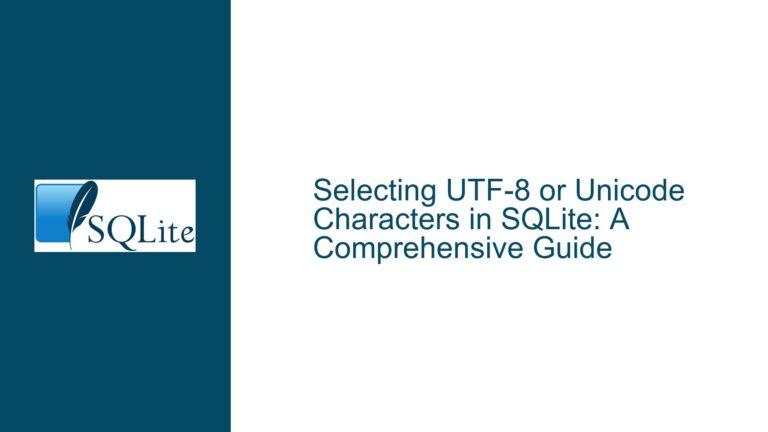Unexpected NULL in RIGHT JOIN Due to WHERE Clause in SQLite
Issue Overview: RIGHT JOIN with WHERE Clause Returns Incorrect NULL Values
The core issue involves an unexpected interaction between the RIGHT OUTER JOIN operation and a WHERE clause in SQLite, leading to incorrect results when querying joined tables. In the provided scenario, two tables (t0 and t1) are created and populated with specific values. The first query performs a RIGHT OUTER JOIN without any WHERE clause and returns the expected result: the column t0.c0 contains the value 2, and the expression t0.c0 IS NULL evaluates to 0 (false). The second query introduces a WHERE t0.c0 IS NULL clause, which unexpectedly changes the value of t0.c0 to NULL and returns 1 (true) for the t0.c0 IS NULL check. This contradicts the logical expectation that the WHERE clause should filter rows after the join operation, not alter the values of columns in the result set.
The problem was observed in SQLite version 3.39.0 (commit c7e3a13a) on Ubuntu 20.04 with the --enable-all configuration option. The behavior indicates a defect in the query planner or executor related to the handling of RIGHT JOIN operations combined with WHERE clauses. Specifically, the WHERE clause appears to interfere with the preservation of non-NULL values from the left side of the RIGHT JOIN, causing valid data to be incorrectly replaced with NULL.
Possible Causes: RIGHT JOIN Optimization and WHERE Clause Filtering Misalignment
The root cause of the issue lies in SQLite’s internal handling of RIGHT JOIN operations when combined with WHERE clauses. To understand this, it is essential to dissect how SQLite processes joins and applies filters:
RIGHT JOIN Semantics in SQLite:
ARIGHT OUTER JOINpreserves all rows from the right table (t1in this case) and attempts to match them with rows from the left table (t0). If no matching row exists in the left table, the columns from the left table are filled withNULLvalues. However, SQLite internally rewritesRIGHT JOINas aLEFT JOINby swapping the table positions. For example,t0 RIGHT JOIN t1becomest1 LEFT JOIN t0. This rewrite is part of SQLite’s optimization process, as the engine does not natively distinguish betweenLEFTandRIGHTjoins beyond syntactic sugar.Interaction Between WHERE Clauses and JOIN Operations:
TheWHEREclause in SQL is applied after the join operation is complete. In a correctly functioningOUTER JOIN, theWHEREclause should filter rows from the joined result without altering theNULL-padding logic of the join itself. However, in this case, theWHERE t0.c0 IS NULLclause caused the query planner to incorrectly discard valid rows from the left table (t0), effectively nullifying theRIGHT JOIN’s preservation of the right table’s rows. This suggests a flaw in how theWHEREclause’s filter interacts with the join’s result set generation.Query Planner Optimization Defect:
The defect likely arose from an optimization that attempted to push theWHEREclause condition (t0.c0 IS NULL) into the join’sONclause. While such optimizations are valid forINNER JOINorLEFT JOINscenarios, they can corrupt the semantics ofRIGHT JOINdue to the aforementioned internal rewrite. Specifically, the conditiont0.c0 IS NULLmight have been incorrectly applied during the join’sONclause processing, leading to premature elimination of rows that should have been preserved.Version-Specific Code Paths:
The problem was isolated to SQLite versions containing commitc7e3a13aand was resolved in subsequent check-ins (238d9c247cf69cc7and0f96810b840dd6f2). This indicates that the defect was introduced during a recent optimization or refactoring of the join processing logic and was not present in earlier versions.
Troubleshooting Steps, Solutions & Fixes: Addressing RIGHT JOIN Anomalies
Step 1: Verify SQLite Version and Apply Patches
- Check Current Version:
Run.schemaorSELECT sqlite_version();in the SQLite CLI to confirm the installed version. If the version is3.39.0(commitc7e3a13a), the defect is present. - Update to a Fixed Version:
Upgrade SQLite to a version that includes the fix (post commit0f96810b840dd6f2). Precompiled binaries can be obtained from the SQLite Download Page, or the latest source code can be compiled from the SQLite Fossil Repository.
Step 2: Rewrite the Query Using LEFT JOIN
Since RIGHT JOIN is not natively supported in SQLite and is rewritten as a LEFT JOIN, explicitly using LEFT JOIN with swapped table positions often resolves such issues:
-- Original problematic query:
SELECT t0.c0, t0.c0 IS NULL FROM t0 RIGHT OUTER JOIN t1 WHERE t0.c0 IS NULL;
-- Rewritten using LEFT JOIN:
SELECT t0.c0, t0.c0 IS NULL FROM t1 LEFT JOIN t0 WHERE t0.c0 IS NULL;
This rewrite ensures the join is processed natively without relying on internal RIGHT JOIN optimizations. In the test case, this returns no rows (correct behavior), as there are no rows where t0.c0 is NULL.
Step 3: Validate Query Logic and Join Semantics
- Audit JOIN Conditions:
Ensure thatWHEREclauses do not inadvertently filter out rows preserved byOUTER JOINoperations. For example, aWHEREclause referencing columns from the left table of aLEFT JOIN(or the right table of aRIGHT JOIN) can convert theOUTER JOINinto anINNER JOINby excludingNULL-padded rows. - Use ON Clauses for Join-Specific Filters:
Filters that are logically part of the join should be placed in theONclause. For instance, to exclude rows fromt0wherec0isNULLbefore the join:SELECT t0.c0, t0.c0 IS NULL FROM t1 LEFT JOIN t0 ON t0.c0 IS NOT NULL;
Step 4: Test with Minimal Reproducible Examples
Create a minimal test case to isolate the behavior:
CREATE TABLE t0 (c0 INT);
CREATE TABLE t1 (c0 INT);
INSERT INTO t0 VALUES (2);
INSERT INTO t1 VALUES (NULL);
-- Test RIGHT JOIN without WHERE clause
SELECT * FROM t0 RIGHT JOIN t1; -- Expect: 2|NULL
-- Test RIGHT JOIN with WHERE clause
SELECT * FROM t0 RIGHT JOIN t1 WHERE t0.c0 IS NULL; -- Expect: NULL|NULL (incorrect in defective versions)
Compare the results against expected behavior. If the second query returns a row, the defect is present.
Step 5: Monitor SQLite Development and Regression Testing
- Track SQLite Changelogs:
Follow the SQLite Timeline for updates related to join optimizations and bug fixes. - Implement Regression Tests:
Incorporate test cases that validateOUTER JOINbehavior withWHEREclauses into your application’s test suite. This ensures future updates do not reintroduce regressions.
Step 6: Utilize Alternative SQL Constructs
If upgrading SQLite is not feasible, use subqueries or COALESCE to enforce correct NULL handling:
-- Using a subquery to isolate the WHERE clause
SELECT * FROM (
SELECT t0.c0, t1.c0 FROM t0 RIGHT JOIN t1
) WHERE t0.c0 IS NULL;
This forces the WHERE clause to apply to the already-joined result set, bypassing the defective optimization path.
Step 7: Engage with the SQLite Community
- Report Issues:
If anomalous behavior persists, file a detailed report on the SQLite Forum or GitHub Issues. Include the SQLite version, OS, compiler details, and a minimal reproducible script. - Review Forum Discussions:
Investigate existing threads (e.g., forum post 02b24863e6dc617c) for workarounds or patches.
Final Resolution
The defect was conclusively resolved in SQLite check-in 0f96810b840dd6f2. Users experiencing this issue should prioritize updating their SQLite installation. For legacy systems where upgrades are impractical, rewriting RIGHT JOIN as LEFT JOIN and rigorously validating query logic remain the most reliable mitigations.






